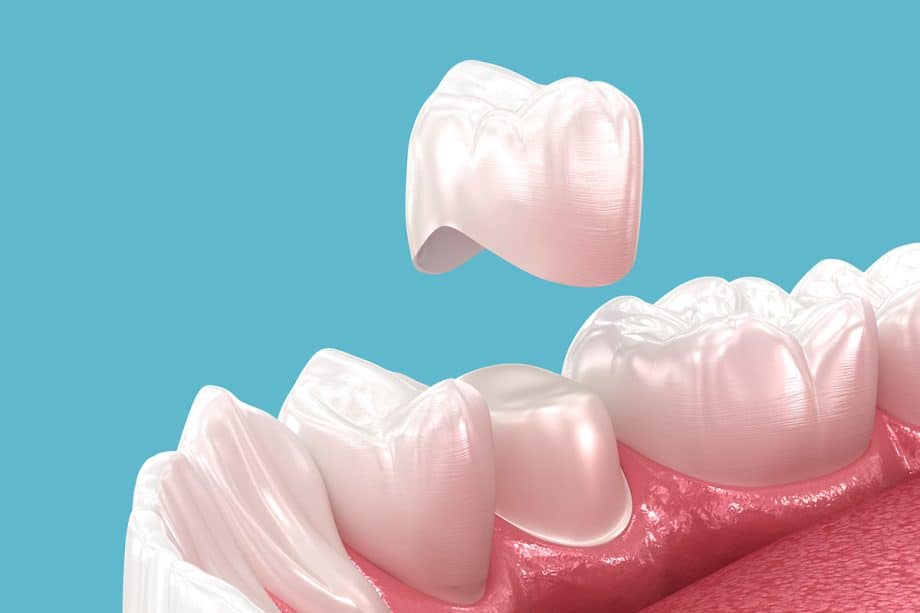Crowns and bridges are common dental restorations for severely damaged or missing teeth. A crown is placed over an existing tooth and a bridge replaces a tooth that is missing using the neighboring teeth for support. These options can last for many years, providing natural function and appearance. But over time they may need to be replaced due to typical wear and tear.
If you have one or more crowns or bridges, you may be wondering how you will know that it needs to be replaced. Here are the signs to look for that indicate that it may be time to visit your dentist.
What is a Dental Crown?
A dental crown is a tooth-shaped cover placed over a tooth that has too much decay or damage for a filling. The tooth is reduced in size and all of the damaged enamel is removed before the crown is placed. The root of the tooth remains in place for support.
Digital impressions (images) are made of the tooth before and after it is prepared to create a precisely fitted crown that matches the size and shape of the original tooth. A porcelain crown is matched to the color of the neighboring teeth for a natural appearance. Crowns can also be silver or gold in color depending on your needs and preferences.
What is a Dental Bridge?
A dental bridge replaces one or more teeth in a row that are missing or too damaged to be saved. It uses the remaining teeth on either side of the gap for support, fitting over them with crowns attached to pontics (artificial teeth). The pontics sit on top of the gums for a natural appearance.
Bridges are typically made of porcelain for chewing strength and a natural appearance. It is made to look just like the teeth that are being replaced in shape, size, and color. Multiple bridges can be used to replace teeth in different locations in your mouth in both the upper and lower jaws.
Why Do Crowns and Bridges Need to be Replaced?
Over time crowns and bridges may need to be replaced. Natural wear and tear from chewing and teeth grinding can take its toll, causing damage to the crown or bridge and even the support teeth. Your crown or bridge may become loose due to changes in your oral health or the structure of your jaw.
Regular maintenance and oral evaluations are key to avoiding complications due to damaged or poorly fitting crowns or bridges. Plaque can gather under loose crowns and bridges, causing the support teeth to decay, potentially leading to tooth loss. Once the support teeth are gone, replacing multiple teeth becomes a much more complex procedure. But by being proactive and having crowns and bridges assessed and replaced at the first sign of a problem, you can avoid more costly and invasive dental prosthetics.
Signs You May Need a New Dental Crown or Bridge
- Visible Damage: Cracks, chips, or fractures in your crown or bridge are obvious signs of damage.
- Discomfort or Pain: Sensitivity, soreness, or bite misalignment may indicate that there is damage to the teeth or jaw bone under crowns and bridges.
- Looseness or Movement: If your crown or bridge feels unstable or wobbly it may need to be replaced to avoid damage to the support teeth.
- Gum Issues: Swelling, redness, or receding gums around the restoration indicates the presence of infection due to plaque bacteria.
- Aesthetic Concerns: Your crown or bridge may develop discoloration over time and become mismatched with surrounding teeth. Replacing it could improve your smile.
If you notice any of these signs, contact your dentist right away. Prompt treatment can help you avoid oral health complications.
How to Prolong the Life of Your Dental Crown or Bridge
- Oral hygiene. Brush twice a day and floss once a day around crowns and bridges as well as your natural teeth. Use a small round brush or a water flosser to clean under bridges.
- Regular dental visits. Go to the dentist every 6 months for cleanings and oral evaluations. Your dentist will inspect your crowns and bridges during each visit and recommend replacement when needed.
- Be mindful of habits. Avoid chewing on hard objects or opening things with your teeth. If you grind your teeth, wear a nightguard to prevent premature damage to your crown or bridge.
Call R. Renan Williams DDS
Restorative dentistry can make it possible to keep your natural teeth in place or provide replacement for teeth that can’t be saved. If you are experiencing problems with an existing crown or bridge, don’t wait. Call R. Renan Williams DDS at 817-281-4801 or contact us today to schedule an appointment. After a brief evaluation we can make a recommendation for the best course of treatment for your oral health.
Frequently Asked Questions About Crowns and Bridges
How long should crowns and bridges last?
On average, porcelain crowns last about 10-15 years and bridges last 5-15 years. Both can last much longer with good care and maintenance, so be sure to practice good oral hygiene habits and schedule regular dental appointments.
Can a loose crown or bridge be recemented?
In some cases an existing crown or bridge can be secured by recementing it. However, in many cases they become loose due to damage to the prosthetic or the tooth underneath. In these cases a new crown or bridge will most likely need to be made, or an alternative tooth restoration option.
At R. Renan Williams DDS we are dedicated to restoring your oral health with the simplest and most effective option. We create personalized treatment plans to meet each patient’s individual needs in a comfortable environment. To learn more and to schedule an appointment, contact us today.

